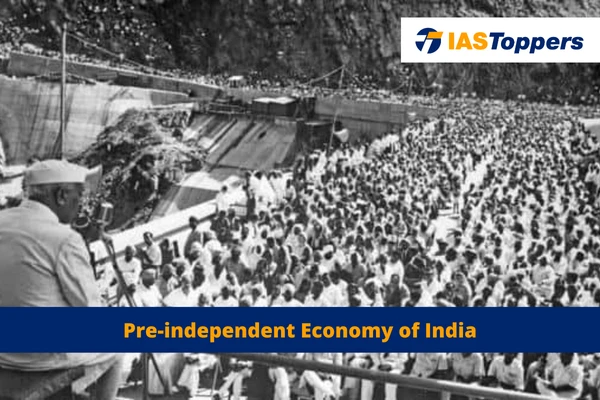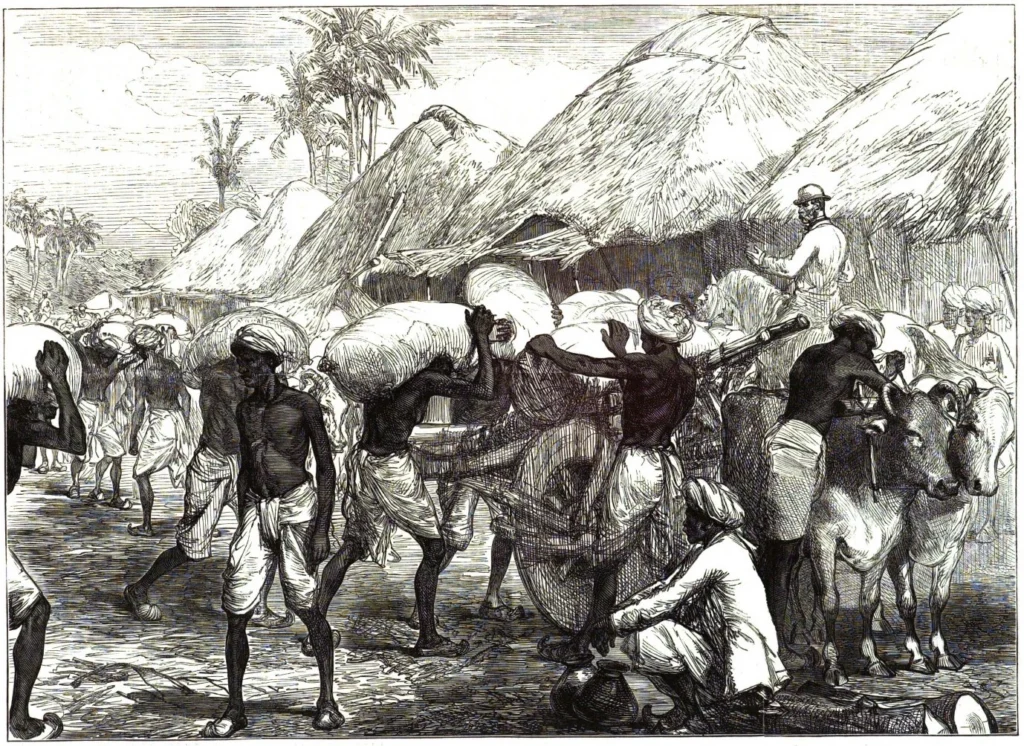Pre-independence economy of India was one where a prosperous India was transformed into a market for British goods, causing an economic shift and socio-cultural impact. Read this article to know all about Pre-independence economy of India. Prior to British rule, India was known for its thriving industries including textiles, metalwork, and crafts. The British restructured the economy to serve their interests, leading to India becoming a raw material provider and a market for British goods. This caused a wealth drain from India to Britain and marked a shift in livelihoods, especially in the agriculture sector which became the main source of income for a majority of the population. In this article, you will know about condition of various industries of Pre-independence economy of India. To explore more interesting UPSC GS Paper – 3 Economy topics, check out other Economic articles and IAS Notes of IASToppers.
Table of Content
- Pre-independence economy of India
- Agriculture during British rule in India
- Industry during British rule in India
- Foreign Trade during British rule in India
- Demographic Condition during British rule in India
- Occupational Structure during British rule in India
- Infrastructure during British rule in India
- Indian Currency and Banking Evolution during British rule
- Social Institutions during British rule in India
- Conclusion
Pre-independence economy of India
- India had an independent economy before the advent of the British rule.
- India was recognized for its craftsmanship in industries like textiles, metalwork, and precious stone crafts.
- The economic plans imposed by the British prioritized the UK’s interests over India’s economic growth.
- This led to India’s transformation into a source of raw materials and a market for British manufactured goods.
- The colonial administration did not attempt to calculate India’s national and per capita income.
- Notable estimators were Dadabhai Naoroji, William Digby, Findlay Shirras, V.K.R.V. Rao and R.C. Desai.
- The colonial era witnessed an enormous outflow of investment capital from India to Britain, causing a drain of wealth.
1. Agriculture during British rule in India
- Agriculture was the primary livelihood for the majority (85%) of the population in India under British rule.
- Agri industry contributed half of the country’s GDP, with 127 million hectares, or 43.6% of India’s total land, dedicated to farming.
- 80% of this agricultural land was designated for food crops. On the other hand, non-food crops occupied about 19%.
- Wheat, rice, millets, sugarcane, cotton, and jute were the primary crops. In terms of global production, India was responsible for 32% of the world’s groundnut yield, 41% of jute, and 27% of rice. Moreover, it held the second position in cotton production, trailing behind the USA and China.
- The influx of machine-made goods from British industries led to the collapse of Indian handicrafts, driving these craftsmen to agriculture for survival.
- Although agricultural productivity was low, the sector experienced some growth due to the expansion of the aggregate area under cultivation.
- However, Agri sector continued to experience stagnation and unusual deterioration.
- The zamindari system, implemented primarily in Bengal, resulted in profits going to zamindars instead of cultivators.
- The other reasons were the increasing population pressure on land resources and the historical negligence of agricultural development under British colonial rule.
- While the cultivation of cash crops increased in certain regions due to agriculture’s commercialization, it failed to improve the farmers’ economic conditions.
- With reduced income, farmers couldn’t afford to maintain their livestock or fertilize their fields adequately. The resulting malnutrition among farming families further hampered their capacity for labor, leading to a deteriorating agricultural sector.
- The lack of organized agricultural markets and government oversight also hindered progress. Farmers, without an organized credit system, relied on local moneylenders for their credit needs.
2. Industry during British rule in India
- Prior to British colonization, Indian industries were handicraft-oriented, known for their skilled artisans.
- This resulted in massive unemployment in India and Indians can’t gey any locally made goods. This demand was met by the increasing imports of cheap manufactured goods from Britain.
- By 1948-49, factories only contributed 6.6% of the national income, employing a small fraction of the workforce.
- The British aimed to deindustrialize India to secure raw materials for Britain and establish India as a market for British products.
- During the 2nd half of 19th century, modern industry began to take root in India but progress remained very slow.
- Prior to WWI, significant growth was only seen in cotton and jute textiles, industries where India held a significant natural advantage.
- From the 1920s, more progressive industrial and fiscal policies began to be adopted, further propelling industrial growth.
- Textile mills (dominated by Indians) were mainly located in western India, while jute mills (dominated by the foreigners) were concentrated in Bengal.
- World War II led to improved utilization of Indian industrial capacity, with subsequent inflation and scarcities shaping the direction of industrial growth.
- By the 20th century, industries like iron and steel started to emerge, with Tata Iron and Steel Company incorporated in 1907. A few other industries in the fields of sugar, cement, paper etc. came up after the Second World War.
- However, the capital goods industry was minimal, hampering industrialization.
- Also, the growth in power generation relied heavily on foreign equipment.
- Manufacturing of synthetic drugs, antibiotics, organic chemicals, and dyestuffs was in its early stages.
- Contribution of new industrial sector to India’s GDP remained very small.
- Factors such as optimal location, raw material availability, market size, and adequacy of financial and technical resources were often overlooked.
- The focus on consumer goods industries was predominant, while the development of basic capital goods industries was notably slow.
- Very limited area of operation of the public sector as it remained confined only to the railways, power generation, communications, ports etc.
3. Foreign Trade during British rule in India
- Due to British policies, India became an exporter of primary products such as raw silk, cotton, wool, sugar, indigo, jute etc. and an importer of finished consumer goods like cotton, silk and woollen clothes and capital goods like light machinery produced in the factories of Britain.
- Over half of India’s international trade was exclusive to Britain, with limited trade permitted with a few countries like China and Sri Lanka.
- The opening of the Suez Canal increased Britain’s dominance over Indian overseas trade.
- India held a significant export surplus, which caused scarcity of necessities like food grains, clothes, kerosene etc. in the local market. This export surplus was used to make payments for the expenses incurred by an office set up by the colonial government in Britain, expenses on war etc.
4. Demographic Condition during British rule in India
- The first comprehensive population data in British India was collected through a 10-yearly census starting in 1881.
- Census revealed the unevenness in India’s population growth.
- Before 1921, India was experiencing the initial phase of demographic transition.
- Post-1921, India entered the second phase of transition with a moderate population and growth rate. As per census, there was unequal population growth across India.
- At the time of Independence, India’s literacy was 17 % and life expectancy at birth was 32.5 years.
- According to Angus Maddison, India’s per capita growth between 1600-1870 was negligible and a mere 0.2% from 1870-1947.
- India’s share of world income reduced from 22.6% in 1700 to 3.8% in 1952.
- The per capita incomes in 1899 was Rs. 18 for 1899.
- No significant changes were observed in production or productivity levels throughout the first half of the 20th century.
- Water and air-borne diseases were widespread due to insufficient public health facilities, resulting in a high mortality rate.
- Overall mortality rate was very high. For example, infant mortality rate was 218 per thousand.
5. Occupational Structure during British rule in India
- There was little shift in the occupational structure, with the majority (70-75%) employed in agriculture, followed by manufacturing (10%), and services (15-20%).
- Regional differences in job distribution began to appear.
- For instance, agricultural employment declined in Madras Presidency, Bombay, and Bengal, while it increased in areas like Orissa and Rajasthan.
6. Infrastructure during British rule in India
- Basic infrastructure such as railways, ports, water transport, saw some development, but with colonial interests in mind.
- Example: Roads constructed mainly catered to military mobilization and raw material extraction. Due to acute shortage of all-weather roads to reach out to the rural areas, people living in these areas suffer during natural calamities.
- Railways, introduced by Lord Dalhousie in 1850, facilitated long-distance travel but negatively impacted village economies as it prompted commercialization of Indian agriculture which adversely affected the self-sufficiency of the village economies in India.
- The volume of India’s exports expanded but its benefits rarely accrued to the Indian people. Thus, social benefits were outweighed by the country’s huge economic loss.
- The inland waterways failed to compete with the railways as many proved uneconomical.
7. Indian Currency and Banking Evolution during British rule
- Prior to British rule, each Indian province had its unique currency, prohibiting inter-provincial trade.
- In 1806, the East India Company introduced the silver rupee as the standard currency unit, which was made a legal tender.
- Modern banking in India emerged between the late 18th and 19th centuries.
- The presidency banks were established in Bengal, Bombay, and Madras in the 1840s, which were unified in 1921 to form the Imperial Bank of India, later renamed as the State Bank of India post-nationalization in 1955.
- The Reserve Bank of India, acting as the central bank, was established in 1935.
- The formation of a network of commercial banks promoted the monetary and market system in the country.
8. Social Institutions during British rule in India
- Before the British came, India had three main social structures: villages that took care of themselves, a caste system, and big families living together.
- When the British left, villages weren’t separate and self-reliant anymore.
- The caste system, which was a big part of Indian society, was starting to be questioned because of economic pressures and western ideologies.
- Joint family systems persisted in rural areas, but started to fade in urban regions.
- In a nutshell, social life in India was going through a transformation when it gained independence.
- The British rule hindered India’s economic progress, which in turn slowed the pace of societal changes as a robust economy was needed for rapid social evolution.
Conclusion
The economic transformation India underwent under British rule had wide-ranging implications, from an industrial collapse to an unsustainable emphasis on agriculture. It led to systemic socio-economic disparities and stagnation. However, even under such constraints, the resilience of Indian society paved the way for slow yet significant developments, planting the seeds for the potential revival of an independent Indian economy.
Ref: Source-1
| Other Articles in Economy | |
| New Industrial Policy 1991 | Capitalism |
| Financial Market | Economic Impact of British Rule in India |
| Funds of Central Government in India | Asian Development Bank |
FAQs (Frequently Asked Questions)
What was India’s economy like before independence?
The pre-independence economy of India was largely agrarian, with farming being the primary livelihood for over 85% of the population. The British turned India into a source of raw materials and a consumer market for their goods, leading to a shift from traditional craftsmanship to an import-dependent economy.
What impact did British rule have on India’s economy?
British rule transformed India’s thriving economy into a raw material supplier for Britain, leading to deindustrialization. It led to the stagnation of the Indian agriculture sector and promoted the drain of wealth from India to Britain




